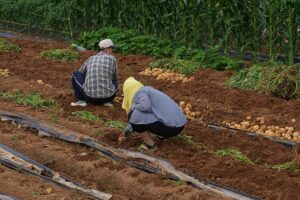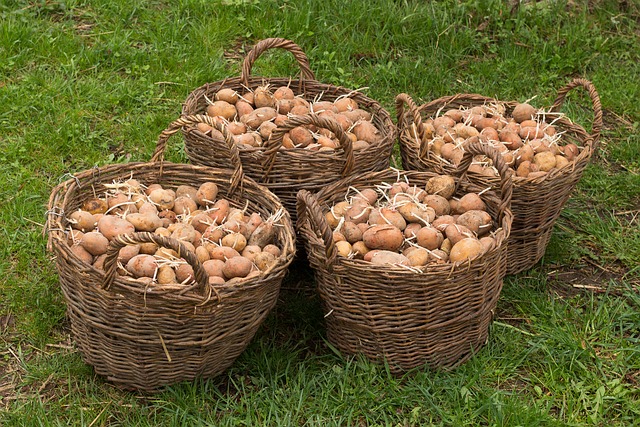Potato farming is a rewarding venture, whether you’re a seasoned farmer or a gardening enthusiast. Potatoes are a versatile and nutrient-rich crop that can thrive in various climates with the right care and knowledge. In this comprehensive guide, we’ll explore the essentials of potato farming, including potato planting depth, choosing seed potatoes, when to plant potatoes, growing potatoes in Texas, and the best months to plant your crop.
Understanding Potato Planting Depth
The depth at which you plant your potatoes is crucial for healthy growth and optimal yield. Potatoes need enough soil coverage to develop a strong root system and tubers while preventing exposure to light, which can cause greening and toxicity.

Ideal Planting Depth
– Seed Potatoes: Plant seed potatoes about 4 to 6 inches deep. This depth ensures they are well-covered and protected from light while allowing the shoots to reach the surface efficiently.
– Trenching and Hilling: Begin by digging a trench about 6 inches deep. Place the seed potatoes in the trench and cover them with 3 to 4 inches of soil. As the plants grow, gradually hill the soil around the stems, adding 2 to 3 inches of soil each time until the hill reaches about 12 inches high.
Choosing the Best Seed Potatoes
Seed potatoes are the foundation of a successful potato crop. They should be disease-free and of high quality to ensure healthy plants and abundant harvests.
Selecting Seed Potatoes
– Certified Seed Potatoes: Purchase certified seed potatoes from reputable suppliers. These are inspected for diseases and have a higher chance of producing vigorous plants.
– Variety Selection: Choose varieties suited to your climate and soil conditions. Popular options include Russet, Yukon Gold, and Red Pontiac. Experiment with different varieties to find the best fit for your region.
– Prepping Seed Potatoes: Cut larger seed potatoes into pieces, ensuring each piece has at least one or two “eyes” or buds. Allow the cut pieces to cure for a few days before planting to reduce the risk of rotting.
When to Plant Potatoes
Timing is crucial for planting potatoes. Planting too early or too late can affect your crop’s success.

Best Planting Time
– Soil Temperature: Plant potatoes when the soil temperature reaches 45°F (7°C) to 50°F (10°C). Cold, wet soil can cause seed potatoes to rot, while warm soil encourages sprouting and growth.
– Frost-Free Date: In most regions, plant potatoes 2 to 4 weeks before the last expected frost date. This timing allows the plants to establish before the heat of summer arrives.
Texas presents unique challenges and opportunities for potato farming due to its diverse climate and soil conditions. Understanding these factors can help you achieve a successful potato crop in the Lone Star State.
Texas-Specific Considerations
– Climate Zones: Texas spans several climate zones, from arid regions in the west to humid areas in the east. Potatoes thrive in cooler temperatures, so choose varieties and planting times suited to your specific region.
– Soil Preparation: Texas soils vary widely, so it’s essential to prepare your soil properly. Potatoes prefer well-drained, sandy loam soil with a pH between 5.0 and 6.5. Amend heavy clay soils with organic matter to improve drainage and fertility.
– Watering Needs: Consistent moisture is vital for potato growth. In Texas, where temperatures can soar, ensure your potato plants receive about 1 to 2 inches of water per week, either through rainfall or irrigation.
What Month to Plant Potatoes
The best month to plant potatoes depends on your location and climate. Here are general guidelines for different regions:
Northern Hemisphere
– Cool Climates: In cooler climates, such as the northern United States and Canada, plant potatoes from late April to early May. This timing allows for optimal growth during the cool spring and early summer months.
– Mild Climates: In regions with milder climates, such as the Pacific Northwest, plant potatoes from March to April. The cool, moist conditions are ideal for potato development.
Southern Hemisphere
– Warm Climates: In warmer climates, such as the southern United States and Australia, plant potatoes in January or February. This timing avoids the intense summer heat and allows for a spring harvest.
– Texas: In Texas, the ideal planting time is generally from February to early March. This schedule helps the plants establish before the hottest months and take advantage of the milder spring weather.
Additional Tips for Successful Potato Farming
Crop Rotation
Rotate your potato crop each year to prevent soil-borne diseases and pests. Avoid planting potatoes in the same spot more than once every three years.
Pest and Disease Management
Monitor your potato plants for common pests like Colorado potato beetles and aphids. Use organic or chemical controls as needed, and practice good garden hygiene to minimize disease risks.
Harvesting and Storage
Harvest potatoes when the plants begin to yellow and die back. Cure the harvested tubers in a cool, dark place for two weeks before storing them in a cool, humid environment to extend their shelf life.
Conclusion
Potato farming is a fulfilling endeavour that can yield delicious and nutritious crops with the right knowledge and practices. By understanding the importance of potato planting depth, selecting quality seed potatoes, timing your planting correctly, and adapting your methods for growing potatoes in Texas, you can enjoy a bountiful harvest. Whether you’re a hobbyist or a professional farmer, these tips will help you cultivate healthy and productive potato plants. Happy farming!
—




